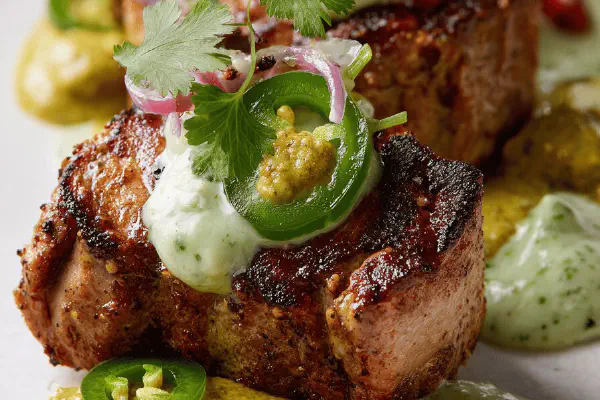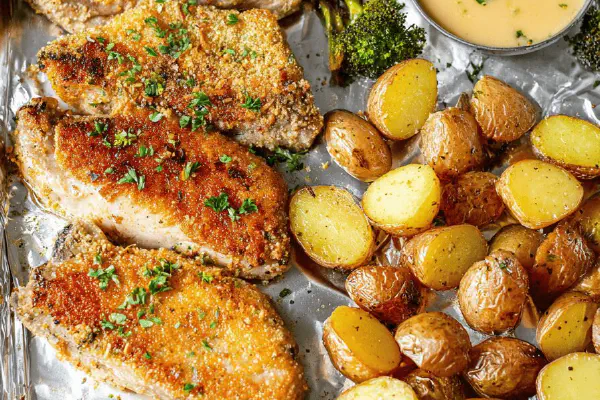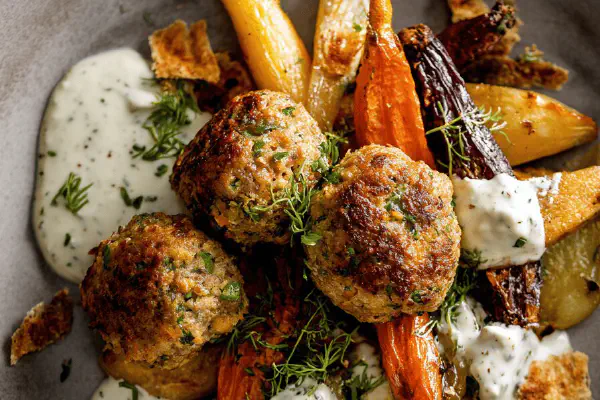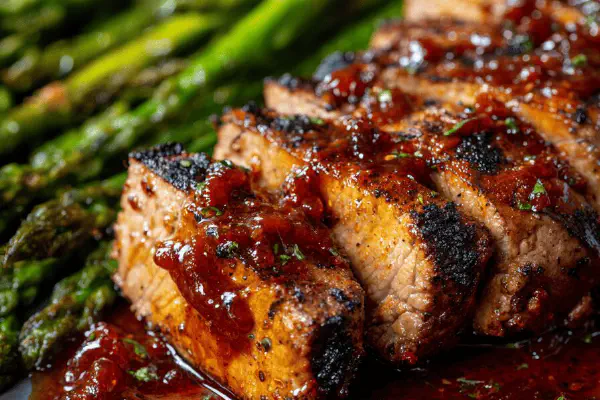Roast Pork Filets Trio

By Emma
Certified Culinary Professional
Ingredients
Roast Pork Filets
- 2 pork filets, about 500 g (1.1 lb) each
- 15 ml (1 tbsp) olive oil
- salt and pepper to taste
Coconut-Curry Cashew Sauce
- 2 garlic cloves, minced
- 7 ml (1 1/2 tsp) fresh grated ginger
- 7 ml (1 1/2 tsp) mild curry powder
- 15 ml (1 tbsp) vegetable oil
- 250 ml (1 cup) coconut milk
- 25 ml (1 1/2 tbsp) cashew butter (substituted for peanut butter)
- 20 ml (1 1/3 tbsp) toasted cashews, roughly chopped (peanuts replaced)
- 1 green onion, chopped
- 1 lime, zest and juice
- 2 ml (1/3 tsp) brown sugar
Coriander-Jalapeño Mayonnaise
- 120 ml (1/2 cup) mayonnaise
- 25 g (1/2 cup) packed cilantro stems and leaves
- 1 garlic clove, roughly chopped
- 1/2 jalapeño, seeds removed, chopped
- 15 ml (1 tbsp) fresh lemon juice
- 3 ml (2/3 tsp) ground cumin
- salt and pepper as needed
Olive and Preserved Lemon Sauce
- 1 small shallot, minced
- 15 ml (1 tbsp) ghee (substituted for butter)
- 75 ml (1/3 cup) dry white wine
- 350 ml (1 1/2 cup) beef stock
- 45 g (1/4 cup) pitted black olives, chopped
- 25 ml (1 1/2 tbsp) toasted all-purpose flour
- 20 ml (1 1/2 tbsp) chopped flat-leaf parsley
- 15 ml (1 tbsp) preserved lemon rind, diced
About the ingredients
Method
Roast Pork Filets
- Set rack mid-oven. Preheat to 210 °C (410 °F) for a hotter short roast; browning first is non-negotiable. Heat olive oil in ovenproof pan until shimmering, put pork in, give each side a solid 2 minutes until golden crust forms. Salt, pepper as you go. Immediate color change. Transfer pan to oven, roast around 10-14 min, meat thermometer test mandatory; aim 58 °C (136 °F) so carryover resting won’t dry it. Rest 7 minutes loosely tented—important. Slice crosswise. Juices will redistribute if you wait. Swap pan for two skillets if crowded.
Coconut-Curry Cashew Sauce
- In small saucepan, warm veg oil over medium, toss in garlic, ginger, curry powder; aromatic bubbles after 30 seconds means release. Pour in coconut milk, stir until uniform. Add cashew butter, chopped nuts, lime zest, juice, green onion last for brightness. Reduce heat to low, simmer gently 6-8 min stirring often; sauce should thicken, coat spoon. Adjust sweet-sour balance with sugar. Should smell nutty and spiced but clean, no bitterness from curry. Keep warm. Use cashew butter for richer mouthfeel, peanut butter can overpower or break sauce if overheated.
Coriander-Jalapeño Mayonnaise
- Dump mayo, cilantro, jalapeño, garlic, lemon juice, cumin into mini processor. Blitz until emulsified and smooth—some texture is okay. Taste for heat; add jalapeño bits if you want more pop or seed for extra bite, but temper if sensitive. Season with salt, pepper. Store tightly covered up to 5 days. Great for crisp freshness that cuts fatty pork. Swap lime juice if needed; lemon offers milder edge.
Olive and Preserved Lemon Sauce
- Ghee melts with faint sizzle in small pan medium heat. Sweat shallots until translucent, softening precisely, about 2 minutes, no browning or burnt edges. Add white wine, vigorous boil until reduced by half, concentration visible — pan bottom dry spots appear. Mix in beef stock, olives, flour, whisk fast so no lumps form. Simmer 4-6 min, sauce thickens, no raw flour taste, glossy sheen. Stir in parsley, diced preserved lemon last for punch and visual color. Taste before salt; stock and olives bring saltiness. Ghee over butter adds nuttier flavor and better smoke point. Proud of this layered sauce—the lemon brightens dark flavors.
- Serve pork filets with choice of sauce. Slice and drizzle or dollop mayo for contrast. Sauce consistency key: too thin, tighten with reduction; too thick, loosen with stock or coconut milk. If using peanut butter, roast nuts lightly beforehand, or risk heaviness. Always rest meat, trust your nose: sweet caramel, toasted crust, and garlic promises done meat and sauces ready.
Cooking tips
Chef's notes
- 💡 Browning meat is a must. Hot oil shimmering, crackling sounds signal ready pan. Two minutes each side forms crust that traps juices. Avoid crowding pan; if filets touch, no crust, moisture escapes. Resting loosely tented seven minutes redistributes juices; slice right after resting—too soon sprays moisture, too long cools meat.
- 💡 Cashew butter swaps peanut butter for gentler flavor, less chance sauce breaks when heated. Saute garlic, ginger, curry powder quick—30 seconds, bubbles rise; no burning. Coconut milk poured slowly to keep texture uniform. Simmer low, stir often to thicken; too hot, sauce separates, gritty. Lime zest and juice last; fresh bright pop offsets richness.
- 💡 Jalapeño mayo blitzed with cilantro and garlic. Seed removal controls heat—start mild. Pulse briefly for texture, not puree. Add salt last; mayo acidity varies. If allergic to jalapeño, swap with serrano or omit but lose that kick. Store covered; flavors meld but can lose brightness after days. Swap lime for lemon juice if gentler tang preferred.
- 💡 Olive preserved lemon sauce needs control. Ghee melts with faint sizzle; no browning shallots, translucent only. White wine boils vigorously till half gone—watch color change, dry spots signal concentration. Mix flour with cold stock before adding; whisk fast to dodge lumps. Simmer 4-6 minutes to gloss, no raw flour bite. Parsley and lemon last for fresh notes. Salt check essential, olives and stock salty already.
- 💡 Timing tweaks matter. Roasting at 210 degrees short and sharp; thermometer aim 58 °C internal—resting carryover hits perfect doneness without dry edges. If no thermometer, press center for spring; gentle bounce means good. Cashew sauce sweet-sour balance tip: add sugar gradually; too much dulls spices, too little sharpens. Use fresh garlic and ginger exclusively; powder kills aroma and texture, ruins sauce complexity.
Common questions
How to know pork is done?
Thermometer best—58 °C internal. No thermometer? Press center—springs back but not too firm. Look crust color, sniff garlic, caramel aroma. Resting crucial; juices redistribute. Slice after rest for juice retention.
Can I use peanut butter in cashew sauce?
You can but risk heaviness or sauce breaking. Roast peanuts first if you try. Cashew butter milder, less oily. Almond butter works too, flavor shifts. Heat gently to avoid separation.
Sauce too thin or thick?
Thin? Reduce over low heat till coats spoon. Thick? Add small amounts stock or coconut milk. Flour lumps? Whisk cold stock and flour before mixing. Patience on sauce key, never rush simmer or risk texture fall apart.
Best way to store sauces?
Tight containers in fridge. Cashew-curry and mayo up to 5 days. Lemon-olive sauce safe 3-4 days max. Reheat gently to avoid breaking. If frozen, texture shifts possible. Always check aroma, color before using.



